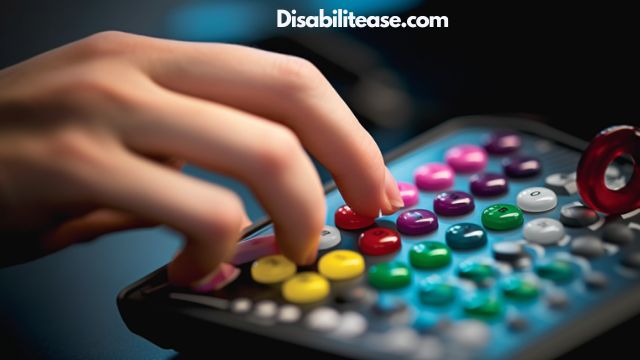Communication is an important part of our daily lives. With the right tools and techniques, disabled individuals can participate in conversations just like everyone else.

In this article, we’ll explore some ways to make communication more accessible for those with disabilities.
Table of Contents
Tips For Making Communication More Accessible For Disabled People
Along the way, you’ll learn about assistive devices, voice-recognition software, and how to make documents more accessible.
Let’s get started!
Utilizing Assistive Devices
You can use assistive devices to make communication more accessible for disabled individuals. There are a variety of technologies available that allow for greater access to communication, such as text-to-speech software, or keyboards with adjustable controls.
These tools offer the ability to adjust settings and controls in order to customize the experience for each user’s needs.
Assistive devices also provide feedback so that users can track their progress and understand what they’ve accomplished. Additionally, voice recognition technology has become increasingly popular as an assistive device.
This technology allows users to have conversations with computers, phones, or other electronic devices without needing manual input.
It is also able to detect subtle changes in speech patterns and vocal tones which can enable better communication between those with hearing impairments and their peers. Innovations like these are making it easier than ever before for disabled individuals to communicate effectively.
With the right combination of hardware and software assistance, these individuals can now participate in meaningful conversations without having any physical limitations hold them back from achieving their goals.
Leveraging Voice-Recognition Software

Leveraging voice-recognition software can help those who are disabled take control of their communication needs. Such technology is designed to recognize and interpret spoken words, allowing users to dictate text that can be transcribed into written form.
It also allows for text to be converted into speech, which makes it easier for people with disabilities to understand what’s been written or said.
This type of technology relies on voice-to-text and text-to-voice conversion algorithms, making it an invaluable tool for improving communication accessibility for individuals with special needs.
The advantages of using this type of software include its accuracy and speed in recognizing and interpreting speech patterns. In addition, the technology is able to quickly convert text into a variety of languages, further increasing access for those whose native language may not be available in traditional formats.
With the right setup, this technology can even create audio feedback when given a command so that disabled individuals have an easy way to interact with virtual assistants or other applications without needing visual cues or physical input devices.
Voice recognition software provides a powerful means for disabled individuals to express themselves more clearly and effectively than ever before – opening up new avenues of communication they may have previously felt excluded from due to their disability.
By taking advantage of these tools, they can gain greater autonomy over how they communicate while also expanding access points where they can do so securely and reliably.
Making Documents Accessible

Making documents accessible is an important part of creating a more inclusive environment. You can start by using accessible formats such as plain text, HTML, or PDFs that are tagged with proper headings and alt-text.
Providing audio descriptions on visual elements like diagrams and infographics helps those with vision impairments understand the content better.
Lastly, utilizing accessible color schemes helps ensure people with colorblindness can view documents correctly.
Using Accessible Formats
It’s essential to ensure communication is available in accessible formats so that everyone can participate.
Text-to-speech and sign language are two options that provide access for those who may be unable to read or hear traditional forms of communication.
Text-to-speech software reads aloud documents, emails, websites, and other materials so that a person with visual impairments can still take part in conversations.
Sign language allows those with hearing impairments to communicate more effectively without relying on auditory cues as they would if using verbal communication only.
With modern technology, it’s now possible to integrate both text-to-speech and sign language into video conferencing programs such as Skype or Zoom, making it easier than ever before for disabled individuals to enjoy the same level of access to communication as their peers.
Providing Audio Description
To further enhance accessibility, audio descriptions can be provided for those with visual impairments to help them gain a better understanding of the content being presented.
Audio description is when a narrator describes what’s happening on screen in order to supplement the dialogue and visuals. This could involve explaining gestures or actions, describing facial expressions, and other nuances that aren’t conveyed through dialogue alone.
Text-to-speech technology can also be used as an accessible format. This allows written text to be converted into spoken words so it can be heard by people with hearing disabilities.
Speech-to-text technology is another option, which enables people with speech impairments to communicate more easily by converting their spoken words into written text.
By employing these technologies, communication becomes much more accessible for disabled individuals. It helps ensure they don’t miss out on important information or conversations.
Utilizing Accessible Color Schemes
Utilizing accessible color schemes is essential for visually impaired people to be able to interact with content and websites effectively. Making sure your website has a high contrast between the text and background helps people with low vision or other visual impairments read the text more easily.
Additionally, using larger fonts allows people who may not be able to see very well to view the content more clearly. Utilizing services such as captioning and text-to-speech can also help provide an additional layer of accessibility for users with hearing impairments as well.
Overall, providing good color schemes as well as captioning and text-to-speech services are great ways to make communication more accessible for disabled individuals.
By considering these options when designing digital products, you can create an environment that is both inclusive and user-friendly.
This will not only allow those with disabilities easier access to websites but also improve their overall experience while interacting with them.
Conclusion
Making communication more accessible for disabled individuals is an important goal that requires effort, creativity, and understanding. There are many ways to do this, including utilizing assistive devices, leveraging voice-recognition software, and making documents accessible.
With these methods in place, disabled individuals can feel included in conversations on both a personal and professional level. It’s essential that we don’t forget the importance of accessibility when it comes to communication. This allows us to bridge the gap between those with disabilities and the rest of society.
We must continue striving towards creating solutions that make communication easier for everyone, so no one is excluded from participating in conversations.

Hi, my name is Eddie, I am a professional trainer specializing in the elderly population and I’m also a website designer. I love training in the gym, going to the beach, traveling, and having good food.
I combined my love for sport and website designing to make “DisabilitEase” whose purpose is to help elderly and disabled people live a more full and active life, have more fun, and enjoy their unique journey despite any disability.


